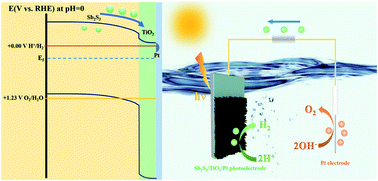A solution processed Sb2S3-based photocathode with enhanced photocatalytic performance via constructing an ultrathin TiO2 overlayer and noble metal modification†
Abstract
Antimony sulfide (Sb2S3) is a light absorbing material with a strong visible light response, which is suitable for efficient and low-cost photoelectrodes. Nano-structured films have unique advantages for constructing photoelectrodes due to enhanced light absorption and carrier migration. However, on account of the low carrier concentration and carrier diffusion length (30–300 nm) of Sb2S3, finding an effective and low-cost method to grow a uniformly-coated ultrathin overlayer on a three-dimensional Sb2S3 film is the key to improve carrier utilization, and is significant to construct a low-cost photocathode with high efficiency. In this work, we report an Sb2S3-based heterostructure photocathode using nanostructured Sb2S3 as a light absorption layer. After coated with the ultrathin TiO2 layer by a simple electrodeposition method and modified with Pt particles, the Sb2S3-based photocathode achieves a photocurrent density of 2.7 mA cm−2 at 0 V vs. RHE in a near-neutral electrolyte, about twelve times higher than that of pure Sb2S3, with an onset potential of +0.55 V vs. RHE. The maximum IPCE of the Sb2S3-based photocathode reaches 17.5% at 700 nm. Our experimental results confirmed the promising application of Sb2S3 as a light absorbing material for photocatalysis, and put forward a facile and effective strategy to coat ultrathin TiO2 on 3D nanostructured films, which will promote further investigation of nano Sb2S3-based photocathodes.



 Please wait while we load your content...
Please wait while we load your content...